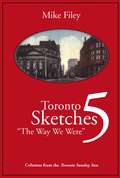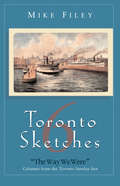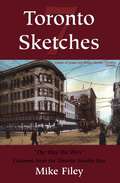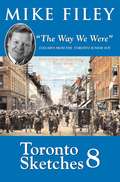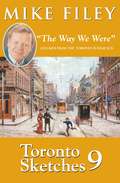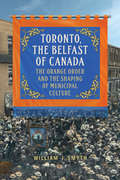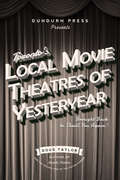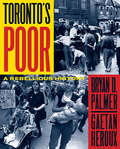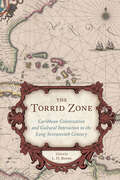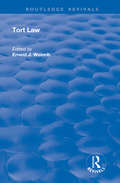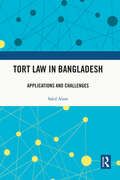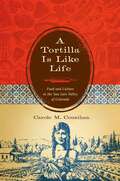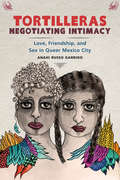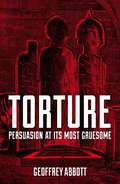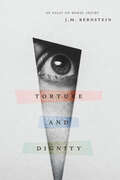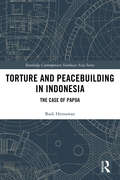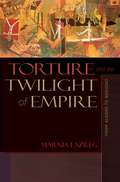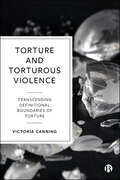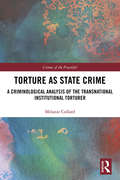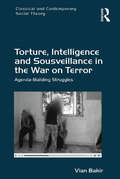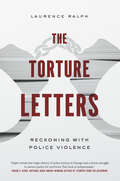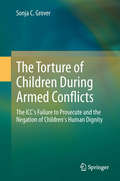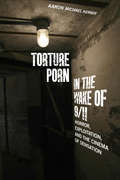- Table View
- List View
Toronto Sketches 5: The Way We Were
by Mike FileyMike Filey’s "The Way We Were" column in the Toronto Sun continues to be one of the paper’s most popular features. In Toronto Sketches 5, the fifth volume in Dundurn Press’s Toronto Sketches series, Filey brings together some of the best of his columns from 1996 and 1997.Each column looks at Toronto as it was, and contributes to our understanding of how Toronto became what it is. Illustrated with photographs of the city’s people and places of the past, Toronto Sketches 5 is a nostalgic journey for the long-time Torontonian, and a voyage of discovery for the newcomer.
Toronto Sketches 6: The Way We Were
by Mike FileyStories of Old Toronto never lose favour with the city’s nostalgia buffs, and as long as Mike Filey continues to provide us with his "The Way We Were" columns, no one’s appetite will have to go unsatisfied.When Mike’s Toronto Sunday Sun columns were first brought together in Toronto Sketches, demand was so high that it prompted a second collection … then a third … and a fourth … and a fifth.Now, for 2000, Mike has once again brought together some of the best of his Toronto Sunday Sun columns for Toronto Sketches 6, the latest installment in the wildly popular series. This time around, Mike takes us to a performance at the Royal Alexandra Theatre by Al Jolson, the opening of Sunnybrook Hospital, a game between the baseball Leafs and the Havana Sugar Kings - with Fidel Castro throwing out the first pitch - and many more famous, notorious, and entertaining episodes in the history of this great city.
Toronto Sketches 7: The Way We Were
by Mike FileyMike Filey is back again with another installment in the popular Toronto Sketches series. Mike’s nostalgic look at the city’s past combines legend, personal anecdotes, and photographs to chronicle the life of an ever-changing city.Among the stories in this volume, Mike looks back to the introduction of the "horseless carriage." He laments the loss of great movie houses of the past - the University, Shea’s Hippodrome, the Tivoli - and applauds those looking to save the Eglinton Theatre, and he tells the history of the King Edward Hotel as it enters its 100th year.Toronto Sketches 7 is a valuable addition to the collection of any fan of Toronto history.
Toronto Sketches 8: The Way We Were
by Mike FileyToronto Sun columnist Mike Filey is back with Toronto Sketches 8, the series that captures the people, politics, and architecture of Toronto’s past with photographs and anecdotes that will change the way you see the city forever. The book brings us back to the time of Toronto’s original horse-drawn streetcar, the construction of Maple Leaf Gardens, and other memories of Toronto, many of which show how history repeats itself, as in the gas price wars of the early 20th century or the debate in 1911 over building a bridge to Toronto island.
Toronto Sketches 9: "The Way We Were" Columns from the Toronto Sunday Sun
by Mike FileyMike Filey’s column "The Way We Were" first appeared in the Toronto Sunday Sun not long after the first edition of the paper hit the newsstands and front porches on September 16, 1973. Since that day more than three decades ago, Mike’s column has enjoyed an uninterrupted stretch as one of the paper’s most popular features. In 1992 a number of his columns were reprinted in Toronto Sketches: The Way We Were by Dundurn Press. Since then another seven volumes of Toronto Sketches have been published, each of which has attained great success both with Toronto book buyers and with former Torontonians wishing to relive an earlier, gentler time in the city’s past.This ninth volume features a variety of stories, including a look at Toronto’s 1904 inferno, the birth of Rex Heslop’s Rexdale community, a visit to Sunnyside Amusement Park, and a few fascinating tales about the city’s streetcars.
Toronto, the Belfast of Canada
by William J. SmythIn late nineteenth-century Toronto, municipal politics were so dominated by the Irish Protestants of the Orange Order that the city was known as the "Belfast of Canada." For almost a century, virtually every mayor of Toronto was an Orangeman and the anniversary of the Battle of the Boyne was a civic holiday. Toronto, the Belfast of Canada explores the intolerant origins of today's cosmopolitan city.Using lodge membership lists, census data, and municipal records, William J. Smyth details the Orange Order's role in creating Toronto's municipal culture of militant Protestantism, loyalism, and monarchism. One of Canada's foremost experts on the Orange Order, Smyth analyses the Orange Order's influence between 1850 and 1950, the city's frequent public displays of sectarian tensions, and its occasional bouts of rioting and mayhem.
Toronto's Local Movie Theatres of Yesteryear: Brought Back to Thrill You Again
by Doug Taylor2017 Theatre Library Association Book Awards — Nominated, Richard Wall Memorial Award 2017 Heritage Toronto Book Award — Nominated Slip once more into the back rows of the favourite movie theatres of your youth. “Brought Back to Thrill You Again” was an advertisement employed by theatres to disguise that they were offering older films that were past their prime. In the 1950s a sign appeared outside Loew’s Downtown (the Elgin) displaying these commonly used words. The theatre was screening Gone With the Wind, released in 1939. However, in this instance the claim was accurate, as the film did indeed thrill audiences one more time. Similar to this cinematic classic, this book will thrill you again as it brings back memories of Toronto’s old movie theatres. Relive the experience of sitting in their darkened auditoriums, witnessing the adventure, comedy, and romance of the silver screen. Most of the theatres have been demolished, but to visually recreate them, the book includes 128 historic pictures of the theatres — exteriors, marquees, colourful neon signs, and auditoriums — many of the photos never before published in books or on the internet.
Toronto’s Poor: A Rebellious History
by Bryan D. Palmer Gaétan HérouxToronto’s Poor reveals the long and too often forgotten history of poor people’s resistance. It details how people without housing, people living in poverty, and unemployed people have struggled to survive and secure food and shelter in the wake of the many panics, downturns, recessions, and depressions that punctuate the years from the 1830s to the present. Written by a historian of the working class and a poor people’s activist, this is a rebellious book that links past and present in an almost two-hundred year story of struggle and resistance. It is about men, women, and children relegated to lives of desperation by an uncaring system, and how they have refused to be defeated. In that refusal, and in winning better conditions for themselves, Toronto’s poor create the possibility of a new kind of society, one ordered not by acquisition and individual advance, but by appreciations of collective rights and responsibilities.
The Torrid Zone: Caribbean Colonization and Cultural Interaction in the Long Seventeenth Century (Carolina Lowcountry and the Atlantic World)
by L. H. RoperThe first comparative history of European settlers’ trading, pirating, and colonizing activities in the Caribbean.Brimming with new perspectives and cutting-edge research, the essays collected in The TorridZone explore colonization and cultural interaction in the Caribbean from the late 1600s to the early 1800s—a period known as the “long” seventeenth century—a time when these encounters varied widely and the diverse actors were not yet fully enmeshed in the culture and power dynamics of master-slave relations. The events of this era would profoundly affect the social and political development both of the colonies that Europeans established in the Caribbean and the wider world.This book is the first to offer comparative treatments of Danish, Dutch, English, and French trading, pirating, and colonizing activities in the Caribbean and analysis of the corresponding interactions among people of African, European, and Native origin. The contributions range from an investigation of the indigenous colonization of the Lesser Antilles by the Kalinago to a look at how the Anglo-Dutch wars in Europe affected relations between the English inhabitants and the Dutch government of Suriname. Among the other essays are incisive examinations of the often-neglected history of Danish settlement in the Virgin Islands, attempts to establish French colonial authority over the pirates of Saint-Domingue, and how the Caribbean blueprint for colonization manifested itself in South Carolina through enslavement of Amerindians and the establishment of plantation agriculture.The extensive geographic, demographic, and thematic concerns of this collection shed a clear light on the socioeconomic character of the “Torrid Zone” before and during the emergence and extension of the sugar-and-slaves complex that came to define this region. The book is an invaluable contribution to our understanding of the social, political, and economic sensibilities to which the operators around the Caribbean subscribed as well as to our understanding of what they did, offering in turn a better comprehension of the consequences of their behavior.“Covering a variety of undertakings, especially English but also Dutch, Danish, French and indigenous, this collection makes a welcome contribution to our understanding of a pivotal period in the history of the West Indies.” —Carla Gardina Pestana, University of California, Los Angeles“This illuminating collection of essays brings the Caribbean squarely into the frame of analysis strongly making the case that the experiences and developments of the Caribbean colonies remained crucial to the history of colonial America. The contributions cover the centrality of enslaved people’s labor and the actions of Indigenous and peoples of African descent who shaped the history of the region through their resistance, accommodation, and engagement.” —Ignacio Gallup-Diaz, Bryn Mawr College
Tort Law: Cases And Materials (The\international Library Of Essays In Law And Legal Theory Ser.)
by Ernest J. WeinribThis title was first published in 2002. The first series of The International Library of Essays in Law and Legal Theory has established itself as a major research resource. The rapid growth of theoretically interesting scholarly work in law has increased a demand for a Second Series which includes significant recent work and also gives an opportunity to include additional areas of law. The new series follows the successful pattern established in the first of reproducing entire essays with the original page numbers as an aid to comprehensive research and accurate referencing. Volume editors have selected not only the most influential essays but those which they consider will be of greatest continuing importance. Each volume has an introduction which explains the context and the significance of the essays chosen.
Tort Law in Bangladesh: Applications and Challenges
by Sakif AlamThis book explores the use of tort laws in Bangladesh, outlining critical studies and cases on key concepts such as nuisance, international torts, negligence, and liability. Drawing from case studies in the UK, USA, Canada, Australia, and India, the volume comparatively analyses various aspects of tort law including its efficacy, issues of determination and monetary considerations. It scrutinizes academic literature and prominent cases such as Bangladesh Beverage Industries Ltd v Rowshan Akhter and Children Charity Bangladesh Foundation v Government of Bangladesh among others to examine the objective and use of tort law in Bangladesh. It also explores fundamental misconceptions related to the use of torts, protection of public and private rights, formalization of tort cases in courts, types of legal remedies for injuries, and more. Lucid and topical, this book will be an essential read for scholars of law, tort law, constitutional law, civil and criminal law as well as for legal professionals especially those concerned with Bangladesh.
A Tortilla Is Like Life: Food and Culture in the San Luis Valley of Colorado (Louann Atkins Temple Women & Culture Series)
by Carole M. CounihanAn innovative portrait of a small Colorado town based on a decade&’s worth of food-centered life histories from nineteen of its female residents.Located in the southern San Luis Valley of Colorado, the remote and relatively unknown town of Antonito is home to an overwhelmingly Hispanic population struggling not only to exist in an economically depressed and politically marginalized area, but also to preserve their culture and their lifeways. Between 1996 and 2006, anthropologist Carole Counihan collected food-centered life histories from nineteen Mexicanas―Hispanic American women―who had long-standing roots in the Upper Rio Grande region. The interviews in this groundbreaking study focused on southern Colorado Hispanic foodways―beliefs and behaviors surrounding food production, distribution, preparation, and consumption.In this book, Counihan features extensive excerpts from these interviews to give voice to the women of Antonito and highlight their perspectives. Three lines of inquiry are framed: feminist ethnography, Latino cultural citizenship, and Chicano environmentalism. Counihan documents how Antonito&’s Mexicanas establish a sense of place and belonging through their knowledge of land and water and use this knowledge to sustain their families and communities. Women play an important role by gardening, canning, and drying vegetables; earning money to buy food; cooking; and feeding family, friends, and neighbors on ordinary and festive occasions. They use food to solder or break relationships and to express contrasting feelings of harmony and generosity, or enmity and envy. The interviews in this book reveal that these Mexicanas are resourceful providers whose food work contributes to cultural survival.&“An important contribution to Mexican American culture.&” ―Oral History Review&“Counihan&’s book is well written and will appeal to a wide spectrum of readers . . . I would recommend this book to those whose interests lie in foodways, gender studies, ethnography and folklore. A Tortilla is Like Life would be a good addition to any reading list, and a beneficial resource for those who desire to understand the complex associations of gender, food, culture and ethnicity.&” —Digest: A Journal of Foodways and Culture
A Tortilla is Like Life: Food and Culture in the San Luis Valley of Colorado (Louann Atkins Temple Women & Culture Series)
by Carole M. CounihanLocated in the southern San Luis Valley of Colorado, the remote and relatively unknown town of Antonito is home to an overwhelmingly Hispanic population struggling not only to exist in an economically depressed and politically marginalized area, but also to preserve their culture and their lifeways. Between 1996 and 2006, anthropologist Carole Counihan collected food-centered life histories from nineteen Mexicanas-Hispanic American women-who had long-standing roots in the Upper Rio Grande region. The interviews in this groundbreaking study focused on southern Colorado Hispanic foodways-beliefs and behaviors surrounding food production, distribution, preparation, and consumption. In this book, Counihan features extensive excerpts from these interviews to give voice to the women of Antonito and highlight their perspectives. Three lines of inquiry are framed: feminist ethnography, Latino cultural citizenship, and Chicano environmentalism. Counihan documents how Antonito's Mexicanas establish a sense of place and belonging through their knowledge of land and water and use this knowledge to sustain their families and communities. Women play an important role by gardening, canning, and drying vegetables; earning money to buy food; cooking; and feeding family, friends, and neighbors on ordinary and festive occasions. They use food to solder or break relationships and to express contrasting feelings of harmony and generosity, or enmity and envy. The interviews in this book reveal that these Mexicanas are resourceful providers whose food work contributes to cultural survival.
Tortilleras Negotiating Intimacy: Love, Friendship, and Sex in Queer Mexico City
by Anahi Russo GarridoTortilleras Negotiating Intimacy: Love, Friendship, and Sex in Queer Mexico City is the first ethnography in English to focus primarily on women’s sexual and intimate cultures in Mexico. The book shows the transformation of intimacy in the lives of three generations of women in queer spaces in contemporary Mexico City, as their sexual citizenship changes, including references to same-sex marriage and anti-discrimination laws. The book shows how these individuals reconfigure relationships through marriage, polyamory, friendship, and sex. Tortilleras Negotiating Intimacy suggests that “new” intimate cartographies are emerging in Mexico City, ultimately redefining relationships, gender, and mexicanidad. Building on ethnographic data collected over the past decade, including forty-five in-depth interviews with women between the ages of twenty-two and sixty-five participating in LGBT spaces, Tortilleras Negotiating Intimacy shows how lesbian women (mainly cis, but some trans) negotiate friendship, same-sex marriage, polyamory, and sexual practices, reinventing love, eroticism, friendship, and ultimately the social organization of Latin American societies.
Torture: Persuasion at its Most Gruesome (You Know You're ... Ser.)
by Geoffrey AbbottIn this classic account of the history of torture, Geoffrey Abbott guides us through some of the worst torture methods known to man, from chilli powder punishment to needles under nails, with a style both chilling and full of dark humour.
Torture: Persuasion at its Most Gruesome (You Know You're ... Ser.)
by Geoffrey AbbottIn this classic account of the history of torture, Geoffrey Abbott guides us through some of the worst torture methods known to man, from chilli powder punishment to needles under nails, with a style both chilling and full of dark humour.
Torture and Dignity: An Essay on Moral Injury
by J. M. BernsteinIn this unflinching look at the experience of suffering and one of its greatest manifestations--torture--J. M. Bernstein critiques the repressions of traditional moral theory, showing that our morals are not immutable ideals but fragile constructions that depend on our experience of suffering itself. Morals, Bernstein argues, not only guide our conduct but also express the depth of mutual dependence that we share as vulnerable and injurable individuals. Beginning with the attempts to abolish torture in the eighteenth century, and then sensitively examining what is suffered in torture and related transgressions, such as rape, Bernstein elaborates a powerful new conception of moral injury. Crucially, he shows, moral injury always involves an injury to the status of an individual as a person--it is a violent assault against his or her dignity. Elaborating on this critical element of moral injury, he demonstrates that the mutual recognitions of trust form the invisible substance of our moral lives, that dignity is a fragile social possession, and that the perspective of ourselves as potential victims is an ineliminable feature of everyday moral experience.
Torture and Peacebuilding in Indonesia: The Case of Papua (Routledge Contemporary Southeast Asia Series)
by Budi HernawanState-sponsored torture and peacebuilding encapsulate the essence of many of the current conflicts in Indonesia. Papua in particular provides a thought-provoking example of the intricacy and complexity of building peace amidst enduring conflict and violence. This book examines the complex power relations that have constructed the gruesome picture of the fifty-year practice of torture in Papua, as well as the ongoing Papuan peacebuilding movements that resist the domineering power of the Indonesian state over Papuans. Conceptualising ‘theatres of torture and peace’, the book argues that torture in Papua is performed in public by the Indonesian state in order to communicate its policy of terror towards Papuans - it is not meant for extracting information, gaining confessions or exacting punishment. A Torture Dataset is provided, codifying evidence from a broad range of cases, collected through sensitive interviews. In examining the data, the author crafts a new, more holistic framework for analyzing cases of torture and employs an interdisciplinary approach integrating three different theories: Foucault’s theory of governmentality and sovereignty, Kristeva’s theory of abjection and Metz’s theory of memoria passionis (the memory of suffering). The book successfully establishes a new understanding of torture as ‘public theatre’ and offers a new perspective of strengthening the existing Papuan peacebuilding framework of Papua Land of Peace. It will be of interest to academics working on Southeast Asian Studies, Peace and Conflict Studies, Transitional Justice, Peacebuilding, Human Rights and Anthropology of Violence.
Torture and the Twilight of Empire: From Algiers to Baghdad (Human Rights and Crimes against Humanity #26)
by Marnia LazregTorture and the Twilight of Empire looks at the intimate relationship between torture and colonial domination through a close examination of the French army's coercive tactics during the Algerian war from 1954 to 1962. By tracing the psychological, cultural, and political meanings of torture at the end of the French empire, Marnia Lazreg also sheds new light on the United States and its recourse to torture in Iraq and Afghanistan. This book is nothing less than an anatomy of torture--its methods, justifications, functions, and consequences. Drawing extensively from archives, confessions by former torturers, interviews with former soldiers, and war diaries, as well as writings by Jean-Paul Sartre, Albert Camus, and others, Lazreg argues that occupying nations justify their systematic use of torture as a regrettable but necessary means of saving Western civilization from those who challenge their rule. She shows how torture was central to guerre révolutionnaire, a French theory of modern warfare that called for total war against the subject population and which informed a pacification strategy founded on brutal psychological techniques borrowed from totalitarian movements. Lazreg seeks to understand torture's impact on the Algerian population--especially women--and also on the French troops who became their torturers. She explores the roles Christianity and Islam played in rationalizing these acts, and the ways in which torture became not only routine but even acceptable. Written by a preeminent historical sociologist, Torture and the Twilight of Empire holds particularly disturbing lessons for us today as we carry out the War on Terror.
Torture and Torturous Violence: Transcending Definitions of Torture
by Victoria CanningThere is growing acknowledgement that torture is too narrowly defined in law, and that psychological and/or sexualised violence against women is not adequately recognized as torture. Clearly conceptualising torturous violence, this book offers scholars and practitioners critical reflections on how torture is defined and the implications that narrow definitions may have on survivors. Drawing on over a decade of research and interviews with psychologists, practitioners and women seeking asylum, it sets out the implications of the social silencing of torture, and torturous violence specifically. It invites us to consider alternative ways to understand and address the impacts of physical, sexualized and psychological abuses.
Torture as State Crime: A Criminological Analysis of the Transnational Institutional Torturer (Crimes of the Powerful)
by Melanie CollardCan we understand torture by focusing on the torture chamber or even on the states in which it is practiced, or do we have to consider the wider political context in which it is embedded? This is the central question of this book which explores concepts of state crime for understanding and responding to the indirect use of torture by external nation states. Drawing on the cooperation between France and Argentina in Argentina's Dirty War, this book explores the utility of the concept of state crime for understanding and responding to the indirect use of torture by external nation states with a detailed examination of the exportation of torture techniques and training expertise as complicity in torture. Discussing the institutionalisation of torture in its international structural context, this book focuses on examining three alleged manifestations of the torturer: direct perpetrator, institutional perpetrator, and transnational institutional perpetrator. Important reading for those in the fields of criminology, sociology, international relations and human rights law, this book will also be of key interest to scholars and students in the areas of state crime, human rights and imperialism.
Torture, Intelligence and Sousveillance in the War on Terror: Agenda-Building Struggles (Classical and Contemporary Social Theory)
by Vian BakirTorture, Intelligence and Sousveillance in the War on Terror examines the communication battles of the Bush and Blair political administrations (and those of their successors in America and Britain) over their use of torture, first-hand or second-hand, to gain intelligence for the War on Terror. Exploring key agenda-building drivers that exposed the torture-intelligence nexus and presenting detailed case studies of key media events from the UK and USA, this insightful volume exposes dominant political discourses on the torture-for-intelligence policy. Whether in the form of unauthorized leaks, official investigations, investigative journalism, real-time reporting, or Non-Governmental Organisation activity, this timely study evaluates various modes of resistance to governments’ attempts at strategic political communication, with particular attention to ’sousveillance’: community-based recording from first-person perspectives. A rigorous exposition of the power-knowledge relationships constituting the torture-intelligence nexus, which re-evaluates agenda-building models in the digital age and assesses the strength of the public sphere across the Third, Fourth and Fifth Estates, Torture, Intelligence and Sousveillance in the War on Terror will appeal to scholars across the social sciences with interests in media and communication, sociology and social theory, politics and political communication, international relations, and journalism.
The Torture Letters: Reckoning with Police Violence
by Laurence RalphTorture is an open secret in Chicago. Nobody in power wants to acknowledge this grim reality, but everyone knows it happens—and that the torturers are the police. Three to five new claims are submitted to the Torture Inquiry and Relief Commission of Illinois each week. Four hundred cases are currently pending investigation. Between 1972 and 1991, at least 125 black suspects were tortured by Chicago police officers working under former Police Commander Jon Burge. As the more recent revelations from the Homan Square “black site” show, that brutal period is far from a historical anomaly. For more than fifty years, police officers who took an oath to protect and serve have instead beaten, electrocuted, suffocated, and raped hundreds—perhaps thousands—of Chicago residents. In The Torture Letters, Laurence Ralph chronicles the history of torture in Chicago, the burgeoning activist movement against police violence, and the American public’s complicity in perpetuating torture at home and abroad. Engaging with a long tradition of epistolary meditations on racism in the United States, from James Baldwin’s The Fire Next Time to Ta-Nehisi Coates’s Between the World and Me, Ralph offers in this book a collection of open letters written to protesters, victims, students, and others. Through these moving, questing, enraged letters, Ralph bears witness to police violence that began in Burge’s Area Two and follows the city’s networks of torture to the global War on Terror. From Vietnam to Geneva to Guantanamo Bay—Ralph’s story extends as far as the legacy of American imperialism. Combining insights from fourteen years of research on torture with testimonies of victims of police violence, retired officers, lawyers, and protesters, this is a powerful indictment of police violence and a fierce challenge to all Americans to demand an end to the systems that support it. With compassion and careful skill, Ralph uncovers the tangled connections among law enforcement, the political machine, and the courts in Chicago, amplifying the voices of torture victims who are still with us—and lending a voice to those long deceased.
The Torture of Children During Armed Conflicts
by Sonja C. GroverThis book examines selected legal complexities of the notion of torture and the issue of the proper foundation for legally characterizing certain acts as torture, especially when children are the targeted victims of torture. ICC case law is used to highlight the International Criminal Court's reluctance in practice to prosecute as a separable offence the crime of torture as set out in one or more of the relevant provisions of the Rome Statute where children are the particularized targets as part of a common plan during armed conflict. Also addressed is the failure of the ICC to consider that the young age of the victims of torture (i. e. children) should be an aggravating factor taken into account in determining the ICC sentence for those convicted of the torture of civilians, including children, in the context of armed conflict as part of a common plan. The six UN-designated grave crimes against children (including child soldiering for State or non-State forces perpetrating mass atrocities, and sexual violence perpetrated on a systematic and widespread basis against children including child soldiers), it is argued, are also instances of the torture of children as part of a common plan such that separate charges of torture are legally supportable (along with the other charges relating to additional Rome Statute offences involved in such circumstances). Useful legal perspectives on the issue of the torture of children in its various manifestations gleaned from the case law of other international judicial forums such as the Inter-American Court of Human Rights and the ICTY are also examined.
Torture Porn in the Wake of 9/11
by Aaron Michael KernerSaw, Hostel, The Devil's Rejects: this wave of horror movies has been classed under the disparaging label "torture porn." Since David Edelstein coined the term for a New York magazine article a few years after 9/11, many critics have speculated that these movies simply reflect iconic images, anxieties, and sadistic fantasies that have emerged from the War on Terror. In this timely new study, Aaron Kerner challenges that interpretation, arguing that "torture porn" must be understood in a much broader context, as part of a phenomenon that spans multiple media genres and is rooted in a long tradition of American violence. Torture Porn in the Wake of 9/11 tackles a series of tough philosophical, historical, and aesthetic questions: What does it mean to call a film "sadistic," and how has this term been used to shut down critical debate? In what sense does torture porn respond to current events, and in what ways does it draw from much older tropes? How has torture porn been influenced by earlier horror film cycles, from slasher movies to J-horror? And in what ways has the torture porn aesthetic gone mainstream, popping up in everything from the television thriller Dexter to the reality show Hell's Kitchen? Reflecting a deep knowledge and appreciation for the genre, Torture Porn in the Wake of 9/11 is sure to resonate with horror fans. Yet Kerner's arguments should also strike a chord in anyone with an interest in the history of American violence and its current and future ramifications for the War on Terror.
